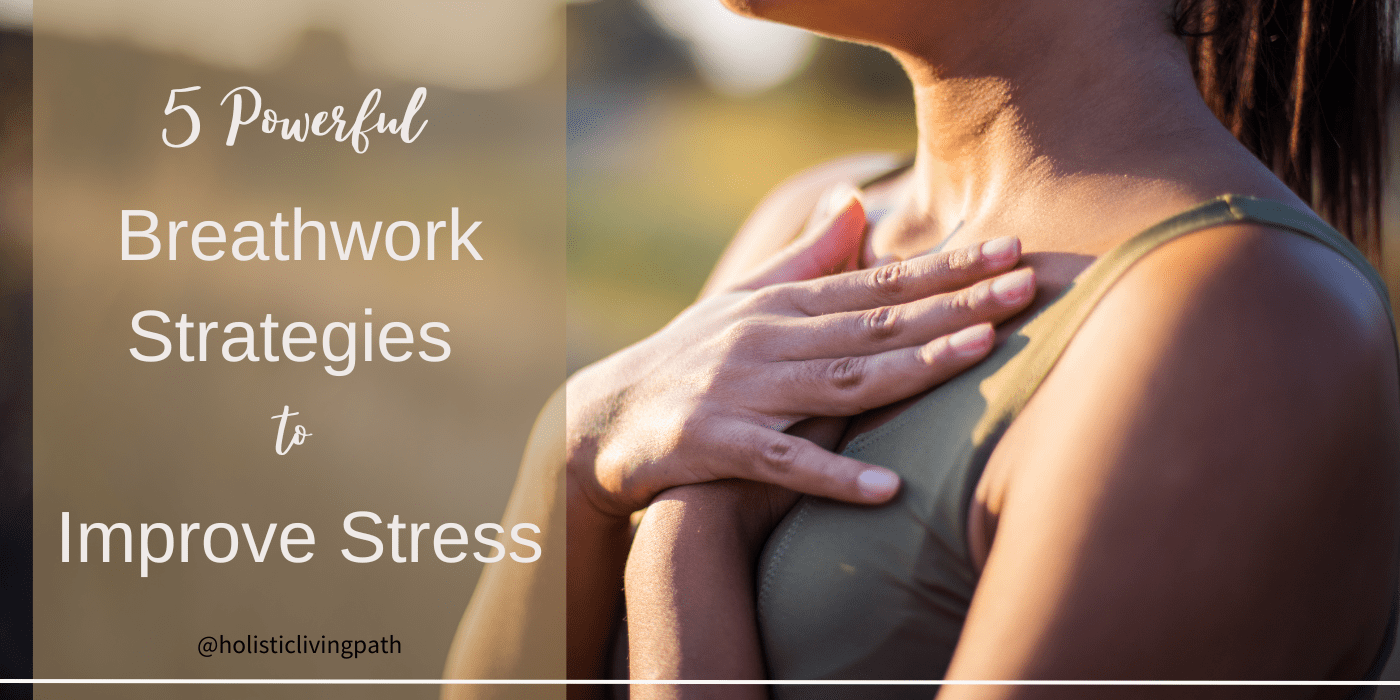
Are you interested in holistic wellness? Do you want to improve your well-being through a holistic lifestyle? Holistic wellness and living can be an amazing lifestyle. If you know how to balance all of its elements—well, that is.
Disclaimer: I only recommend products I would use myself, and all opinions expressed here are our own. This post may contain affiliate links that, at no additional cost to you, I may earn a small commission. Additionally, as an Amazon Associate, I earn from qualifying purchases. Read full the privacy policy here.
When I was first introduced to holistic wellness, I received a lot of conflicting information. To some, holistic wellness was “woo-woo” nonsense or borderline witchcraft.
Related: A Holistic Perspective: The Mind, Body, and Spirit
To others, holistic wellness was “sketchy” at best and lacking evidence of its effectiveness. Regardless, the consensus was that holistic wellness was less than a viable option. Luckily, times have changed and there are more grounds to support a holistic lifestyle.
Truth be told, when I switched to a holistic lifestyle, I was skeptical too. After trying endless medications to combat my chronic pain, I was reluctant to believe that anything could improve my misery.
Despite my skepticism, I gave it a fair shot. I traded medications for meditations, changed my diet, and developed a workout routine.
It wasn’t easy at first and it was a painful change for my aching body, but I noticed major changes in my body and within myself after a few weeks of hard work and dedication.
Related: How to Begin Living a Holistic Life
Sadly, holistic wellness isn’t always about which herbs can improve your pain or which meditation will bring you money. Holistic living is about balancing your physical, emotional, mental, and spiritual needs.
This can be a difficult task, Especially If you’re used to living out of balance. However, these needs can be broken down into 7 major components. By looking at the components more closely, you can transition to a more holistic lifestyle.
What is Holistic Wellness?

Holistic wellness is a way of looking at health that takes into account all aspects of your lives – physical, mental, emotional, spiritual, social and environmental. It focuses on overall wellbeing rather than just treating the symptoms of illnesses or disease.
Holistic wellness looks at how different factors like diet, lifestyle choices and relationships impact your health. In holistic wellness, you strive to create balance and harmony in all these areas in order to achieve true wellbeing.
Related: Want to Live More Sustainably? Read This
What are the 7 Major components?
The 7 major components of holistic wellness are physical health, mental health, emotional health, spiritual health, social health, financial health, and environmental health.
When you understand and take care of these components, you are well on your way to achieving overall holistic wellness. These components play an important role in how you live your life and interact with the world.
Benefits of Understanding Holistic Wellness
The benefits of understanding the components of holistic wellness are immense. Knowing and taking care of all aspects of your health can help you live a more balanced, healthy life. As you become more aware of these factors and how they reflect on your overall wellbeing, you can make changes to improve your health and happiness.
Overall, holistic wellness can reduce stress and anxiety, improve mental clarity, increase energy levels, and even strengthen relationships. Through living a holistic wellness lifestyle, you can gain a deeper understanding of yourself and the world around you.
Related: Grounding Means Living Naturally
Physical Wellness
Physical wellness is one of the seven components of holistic wellness. It is the foundation of a healthy lifestyle and is the basis for all other forms of wellness. Physical wellness involves taking care of your body by engaging in physical activity, eating nutritious foods, and getting enough rest. Regular exercise helps to reduce stress, improve circulation, and strengthen your muscles.

Eating a balanced diet rich in fruits, vegetables, and whole grains provides your body with the nutrients it needs to stay healthy. Not to mention, getting enough rest helps to restore energy levels and keep your immune system strong.
Some signs that your physical wellness is not in balance include:
- fatigue
- chronic pain
- digestive issues
- weight gain or loss
- trouble sleeping
Related: Natural Remedies for Chronic Pain
When your physical wellness is out of balance, it can affect other components of holistic wellness. However, by taking the time to listen to your body can help you identify what needs attention, and create a plan to improve your physical wellbeing.
Some ways to improve your physical wellness include:
- eating balanced meals throughout the day
- taking time to stretch and move your body each day
- getting regular checkups with your doctor
- drinking plenty of water
- getting at least 7-9 hours of restful sleep each night
Mental Wellness

Mental wellbeing is an integral component of holistic wellness. It encompasses not only the absence of mental illness but also an overall sense of wellbeing that comes from having a positive outlook and a healthy lifestyle.
Related: 4 Tips to Take Care of Your Mental Health
Mental wellbeing is often achieved through self-care activities such as mindfulness, yoga, and meditation, or through connecting with family and friends. It is also important to be aware of the warning signs of mental illness and to seek help if needed. Taking care of your mental health is essential for overall holistic wellness.
Some signs that your mental wellness is not in balance include:
- difficulty concentrating
- insomnia
- irritability or restlessness
- excessive fear and worry
- feelings of sadness or hopelessness
Your mental wellness can affect your ability to manage stress and cope with difficult situations. However, there are many ways to improve your mental wellbeing.
Related: Simple Ways to Reduce Stress Holistically
Some strategies for improving mental wellness include:
- creating positive thought patterns by focusing on the good in life
- engaging in activities that bring joy and fulfillment, such as art or music
- practicing self-care activities such as yoga, meditation, or journaling
- indulging in hobbies that bring peace and relaxation
- connecting with friends and family
- seeking help from a mental health professional, if needed
Spiritual Wellness
Spiritual wellness is one of the most important components of holistic wellness. It is the practice of developing an understanding of one’s purpose and inner self. It is the process of understanding and connecting with the deeper meaning and purpose of your lives. Spiritual wellness can be achieved through practices such as meditation, prayer, and mindfulness.
Spiritual wellness can also be nurtured by participating in activities that bring us joy, such as reading, writing, and creating art. These activities allow us to explore your inner selves and connect with your higher purpose. By cultivating your spiritual wellness, you can find greater peace and fulfillment in life.

Related: Common and Powerful Herbs for Spiritual Uses
Some signs that your spiritual wellness is not in balance include:
- feeling lost, confused, or disconnected
- lack of motivation and inspiration
- feeling unfulfilled
- feeling disconnected from your purpose
Some strategies for improving spiritual wellness include:
- engaging in activities that bring you joy
- connecting with nature
- practicing mindfulness and meditation
- reading, writing, or creating art
- engaging in spiritual practices such as prayer
- connecting with those who share similar beliefs
- practice gratitude
Related: 12 Fun Yoga Poses for Improved Digestion
Emotional Wellness
Emotional wellness is an essential component of holistic wellness. It is the ability to recognize and accept your feelings, and to manage them in a healthy way. Emotional wellness involves understanding the cause of your emotions and developing strategies to cope with stress and other difficult situations. It also involves having a positive outlook on life and being able to find joy in the little moments.

Practicing mindfulness can be a great way to achieve emotional wellness. Mindfulness can help you stay grounded and focused, and to be more connected to your emotions. Through mindfulness, you can learn to accept and manage your emotions in a healthier way. In the end, though, emotional wellness is an important part of holistic wellness, and should be actively practiced to maintain a healthy lifestyle.
Some signs that your emotional wellness is not in balance include:
- feeling overwhelmed or anxious
- difficulty managing stress
- extreme sadness or anger
- difficulty sleeping
Related: 4 Proactive Self-Care Tips to a Holistic Life
Some strategies for improving emotional wellness include:
- practicing mindfulness and meditation
- engaging in joyous and fun activities
- getting regular exercise
- spending time with friends and family
- seeking help from a mental health professional, if needed
Social Wellness

Social wellness is an important component of holistic wellness and refers to the quality of your relationships with others. It includes the ability to form meaningful connections with family, friends, and colleagues, and to communicate effectively. It also includes the capacity to interact with others in a positive and respectful way.
To maintain social wellness, it is important to take time to nurture relationships, build a strong support system, and take part in activities that bring joy and fulfillment. Practicing self-care and being mindful of boundaries to ensure that relationships remain healthy and balanced are also crucial. By taking steps to prioritize social wellness, you can create meaningful connections and foster a sense of belonging.
Related: Secrets to a Nurturing Camping Trip That You Need to Know
Some signs that your social wellness is not in balance include:
- feeling isolated or disconnected
- difficulty communicating with others
- lack of meaningful relationships
- difficulty maintaining boundaries
Some strategies for improving social wellness include:
- making time to connect with family and friends
- engaging in activities that bring joy and fulfillment
- practicing assertiveness to set healthy boundaries
- engaging in volunteer work or other meaningful activities
- seeking help from a mental health professional, if needed
Related: Do You Make These Common Mistakes When Living More Naturally?
Financial Wellness
Holistic wellness means considering all aspects of your lives and how they interact with each other. For this reason, financial wellness is an essential component of holistic wellness. It is important to understand the basics of budgeting, saving, and investing, and to prioritize your financial health just as you prioritize your physical and mental health.

Financial wellness is a form of self-care that is often overlooked, but it is essential for achieving a balanced life. Taking the time to understand your finances and how to manage them can make an enormous difference in your overall wellbeing. It is important to create a budget that works for you, to save for both short and long-term goals, and to invest wisely. These are all key components of financial wellness that will help you achieve your desired lifestyle. Taking the time to understand your finances and how to manage them will help you feel empowered and in control of your lives.
Signs that your financial wellness is out of balance include:
- feeling stressed or overwhelmed by your finances
- difficulty budgeting or managing expenses
- living paycheck to paycheck
- feeling anxious about the future
Related: Tips for Self-Care Practices: Improve Journaling Skills
Some strategies for improving financial wellness include:
- creating a budget that works for you
- tracking spending and setting short and long-term financial goals
- seeking help from a financial planner or advisor, if needed
- setting up an emergency fund
- investing wisely and reducing debt
Environmental Wellness
Environmental wellness is an important part of holistic wellness, as it involves taking steps to promote the health of your planet. It includes understanding how your actions impact the environment and making conscious decisions to reduce your environmental footprint.
By taking measures to reduce waste, conserve resources, and live more sustainably, you can help ensure that future generations will have a better quality of life. Additionally, environmental wellness also involves engaging in activities that connect us with nature and promote growth and healing.

Related: How to Create an Amazing and Beautiful Holistic Garden
Some signs that your environmental wellness is not in balance include:
- feeling disconnected from nature
- difficulty reducing waste or conserving resources
- lack of motivation to create a sustainable lifestyle
Some strategies for improving environmental wellness include:
- recycling or composting whenever possible
- engaging in eco-friendly activities such as biking, walking, and camping
- planting a garden or working with an organization dedicated to environmental conservation
- reducing water and energy usage
- minimizing the use of plastics
Related: How to Live a Life With Less Toxic Chemicals
And that’s it! When adopting a holistic lifestyle, it’s important to remember to prioritize all aspects of one’s wellbeing, including physical, mental, emotional, social, financial, and environmental wellness. The key to maintaining holistic wellness is consistent effort and self-awareness. By taking the time to focus on each area and implement mindful strategies for improvement, you can achieve a more balanced lifestyle.
How do you practice holistic wellness? What strategies have you found to be helpful? Share your thoughts with us in the comments below!



